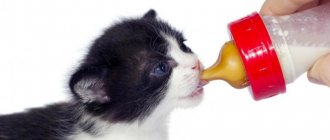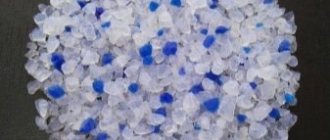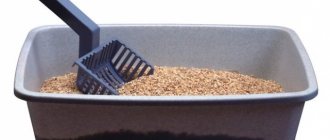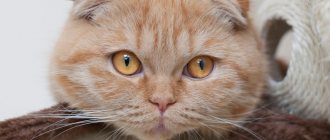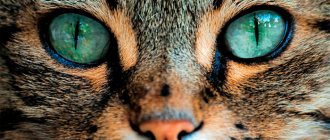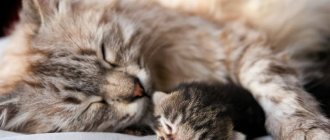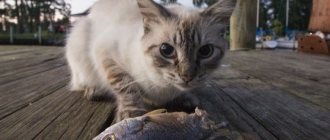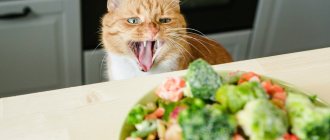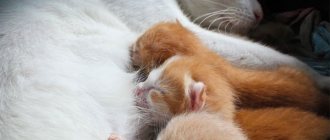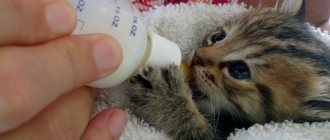Every owner needs to know where to buy and how to choose a cat milk substitute.
After all, sometimes situations arise when a cat, for some reason, is not able to feed kittens.
Cats are very gentle creatures. Newborn kittens should start eating immediately after birth.
That is why the female’s body begins to produce cat milk in advance, before the onset of childbirth.
Maternal colostrum has unique immunomodulatory properties
Sometimes situations arise when a cat, for some reason, is unable or refuses to feed kittens.
Either the animal dies after childbirth or even during its process.
Therefore, every responsible cat owner needs to know what can replace cat milk if necessary.
The first meal of the day for kittens is vital because, together with their mother’s milk (which at first faintly resembles milk and is called colostrum), they receive a portion of antibodies to deadly viruses.
Thus, within 24 hours, babies receive lasting immunity.
It is important to understand that colostrum is unique in composition and cannot be replaced artificially.
Cat milk replacers are intended to be an alternative to milk in the classical sense, which the cat lactates with after colostrum.
Features and composition
When a cat's colostrum turns into full-fledged milk, it can hardly be distinguished from any other milk, including the familiar cow's milk.
Basically, the composition of cat milk is approximately the same as the composition of regular milk, and differs only in the percentage of components:
- About seventy percent of a cat's milk is water. As for the fat content, on average it does not exceed 11%, which is 7% lower than the fat content of human, goat and cow milk.
- The protein content of milk is also about 11%, which is very different from the 2% in women's milk, and the 4% in cow's and goat's milk.
- The amount of lactose is slightly higher than 3%, which is less than in women's (6%), goat and cow's milk (5%).
The composition of cat's milk differs from any other in the proportions of proteins, fats and lactose.
It follows that the ratio of proteins and fat content of cat's milk is significantly higher than in any other, so it is not possible to replace it with natural alternatives.
Cat milk is significantly different from the nutritional fluid of a goat or cow. Human milk is also not suitable for artificial feeding. The fat content of cat's milk is quite high (about 11%) and contains less lactose, which prevents indigestion in the offspring. However, it is rich in proteins, unlike cow and goat.
The percentage ratio is 11:4. Colostrum is considered the most nutritious. It is fatty and provides the baby’s body with protective antibodies, especially if the owner vaccinated the cat no later than 1 year before pregnancy. After a day, the percentage of fat content decreases. And also with mother’s milk, babies receive vitamins, microelements, and minerals.
Dry food can be diluted and given to a nursing mother to establish lactation and increase milk production. The composition of cat milk is unique and replacement with liquid milk products is carried out in the following cases:
- The cat has a litter of over 3-4 kittens.
- Mastitis or postpartum eclampsia.
- Lack or absence of milk in a lactating female.
- Surgical intervention during delivery.
- Refusal of a cat to feed its offspring.
- Death of Mother Cat.
Every owner needs to know where to buy and how to choose a cat milk substitute.
After all, sometimes situations arise when a cat, for some reason, is not able to feed kittens.
Cats are very gentle creatures. Newborn kittens should start eating immediately after birth.
That is why the female’s body begins to produce cat milk in advance, before the onset of childbirth.
Maternal colostrum has unique immunomodulatory properties
Sometimes situations arise when a cat, for some reason, is unable or refuses to feed kittens.
Either the animal dies after childbirth or even during its process.
Therefore, every responsible cat owner needs to know what can replace cat milk if necessary.
Thus, within 24 hours, babies receive lasting immunity.
It is important to understand that colostrum is unique in composition and cannot be replaced artificially.
Cat milk replacers are intended to be an alternative to milk in the classical sense, which the cat lactates with after colostrum.
- About seventy percent of a cat's milk is water. As for the fat content, on average it does not exceed 11%, which is 7% lower than the fat content of human, goat and cow milk.
- The protein in milk is also about 11%, which is strikingly different from 2% in women's milk, and 4% in cow's and goat's milk.
- The amount of lactose is slightly higher than 3%, which is less than in women's (6%), goat and cow's milk (5%).
Since there is no organic alternative for cat milk, some cat food manufacturers have created a line of artificial cat milk substitutes.
They include such components necessary for the kitten’s body as:
- Minerals;
- Vitamins;
- Microelements;
- Amino acid Taurine;
- Omega-6 and Omega-3 fatty acids.
There are several manufacturers of cat milk substitutes; they differ in quality, configuration and composition.
The price of products from different manufacturers also differs. Here are the most popular ones:
- Royal Canin, which also produces food
- Beaphar
- Gimpet
- Canina
- Nutri-Vet
- Dolfos
- Clauder's
- Gimborn
- Hartz
- Trixie
- Vo-Toys
- Camon
The lack of certain “ingredients”, for example, EPA, DHA, arachidonic, linoleic and alpha-linoleic acids (which are found in Omega-6 and Omega-3 fatty acids) can lead to various serious developmental pathologies in the cat.
Among the products of cat milk substitutes, only Royal Canin, Beafar and Gimpet mixtures contain these components, and in the required percentage.
Some owners, when they find out how much an artificial cat milk substitute from a popular manufacturer costs, wonder if it is possible to prepare the mixture at home using ordinary products as ingredients?
Of course, veterinarians do not advise doing this due to the need to include the maximum necessary microelements in the kitten’s diet, but some recipe options still exist:
- The first recipe consists of 20% condensed milk without sugar and water (5:1 proportions), which must be mixed with bone meal in a ratio of one teaspoon per liter of milk. Using this recipe, you can prepare a substitute for newborn kittens;
- The second recipe is based on cow's milk, which requires 0.5 liters. You need to mix one chicken egg yolk and four tablespoons of sugar in milk. Instead of cow's milk, you can use goat's milk or a powdered milk product. Also, 0.3 ml of vitamin supplements in drops (Tetravit or Trivit) should be added to the mixture;
- The third recipe is based on the “Malyutka” infant formula, which should be diluted with water in the proportion specified in the product instructions;
- The fourth recipe is most suitable for newborns, weakened or sick kittens and consists of 100 ml of milk, 20 ml of 5% glucose, one chicken egg yolk, one spoon of vegetable oil, 0.3 ml of vitamin supplements in drops (Trivit or Tetravit), as well as baby Nutrilon mixture.
Such mixtures should be thoroughly mixed until smooth and given to the pet using a bottle with a nipple.
If there is no pacifier available, then you can limit yourself to a pipette or syringe, but in this case you need to feed the animal very carefully so that it does not choke.
The prepared mixture should be heated before feeding to the animal’s body temperature, that is, to 38-39 degrees Celsius.
If the kitten does not eat everything at once, the substitute can be kept in a closed container in the refrigerator, but no more than 24 hours.
When buying a cat milk substitute, you need to understand exactly how to use such mixtures at home so as not to harm the animal and preserve the beneficial properties of the components.
Since milk replacer mixtures are usually so-called “powdered” milk, they must be prepared correctly.
Mixtures should be prepared according to the manufacturer's instructions
Instructions for using substitutes are approximately the same for all manufacturers.
We invite you to find out what breed black cats can be.
Owners need to know several features of this process:
- Powdered milk must be diluted with cooled boiled water in the percentage indicated on the packaging of one or another manufacturer.
- All utensils used should be as sterile as possible, since bacteria should not get on the utensils or in the substitute;
- Hands should be washed clean, especially if the kittens have not received cat colostrum at all;
- You should not buy mixtures in large packages, since during long-term storage various pathogenic bacteria can get into the cat's milk replacer. This does not apply to Royal Canin cat milk replacers, the powder portions of which are packaged in separate bags for long-term and sterile storage;
- The prepared mixture should also not be stored under any circumstances - it is best to immediately throw out the leftovers left uneaten by the kitten.
- If the packages of milk replacers from the manufacturers Katzenmilch, Royal Canin BabyMilk, Hartz include special bottles and nipples, then the Beafar and Gimpet packages do not have them. Accordingly, you need to stock up on a feeding kit with these mixtures in advance.
- Under no circumstances should kittens be given water from a syringe or spoon - this is extremely inconvenient and also dangerous for the pet, because it can die if it chokes or cannot cope with rapidly developing pneumonia. An animal can also die if some of the food gets into its lungs.
The finished mixture must be measured correctly; for this, for example, manufacturers of some mixtures include in the packaging a special measuring spoon and three nipples of different sizes for the convenience of feeding the animal as it grows.
When and in what dosage is it best to feed a kitten?
First of all, it all depends on his age and breed.
Kittens of large breeds, say, Maine Coon, Norwegian Forest Cat, Kurilian Bobtail, Pixie Bob, Ragdoll, Turkish Van, are much larger physically than their counterparts.
Accordingly, their need for nutrients for normal development is higher.
Savannah kittens are among the tallest
The amount of mixture required looks like this:
- From one to four days – 30-32 ml;
- From five to fourteen days – 37-39 ml;
- From fifteen to twenty-five days – 44-47 ml;
- from twenty-six to thirty-six days 52-55 ml.
You need to monitor your pet's weight gain every day
To calculate the exact dosage of the diet your kitten needs, you need to monitor its weight gain and the animal’s health condition daily.
Cat milk replacer dosage table
Although the table provides complete information about the dosage, it is necessary to determine as accurately as possible whether the kitten is full or not.
This is necessary because both overfeeding and underfeeding are dangerous for his body.
Recipes for making your own mixture
If the kitten tolerates pasteurized cow's milk well, then you can make him dishes based on it. To prepare the classic recipe you will need:
- a glass of warm milk;
- 2 chicken egg yolks;
- vegetable oil - 1 teaspoon;
- 1 drop of multivitamin solution (for example, Trivita or Tetravita).
If the kitten is very weak and thin, you can prepare a sweet mixture based on condensed milk - it contains enough fats and carbohydrates so that the baby quickly gains weight and gets stronger. It is made according to the following recipe:
- Condensed milk is mixed with water in a ratio of 1:5.
- Add bone meal at the rate of 1 teaspoon per liter of liquid.
This dish is only allowed to be given to kittens over 1 week old. Suitable only for emergency feeding (after 5–7 days you should switch to a regular formula with milk or a powder substitute).
How to choose a product?
If for some reason a kitten cannot receive mother's milk, pet product manufacturers offer to buy an industrial substitute. This is a mixture similar in composition and nutritional properties to cat milk. She must:
- contain a minimal amount of lactose (the kitten’s digestive tract is not able to digest a large dose of the enzyme);
- provide the daily calorie intake for the healthy development of the baby’s skeleton and organs, normal weight gain (about 10 grams per day);
- be enriched with useful minerals and vitamins (calcium, Omega 3 and 6, taurine, choline) and do not contain starch;
- have a fat content of at least 8%.
If babies live with their mother cat, she herself monitors their nutrition. Kittens eat as soon as they get hungry. When a small furry pet grows up alone, the responsibility of maintaining a feeding schedule falls on your shoulders. Depending on the age of the baby, the norm is for every 100 grams. the weights look like this:
- 1-4 days – 30 ml;
- 5-14 days –40 ml;
- 15-25 days – 45 ml;
- 25-35 days – 55 ml.
Thus, if the kitten you are feeding is 10 days old and weighs 170 grams, he needs to be given 40*1.7 = 68 ml of formula per day.
Usually, the manufacturer includes instructions in the box of powdered milk replacer. If it is not found, follow the general recommendations of veterinarians. Remember that if you feed your furry baby 5 times a day, the norm described above must be divided by 5. You will need a bottle with divisions, a measuring spoon and nipples of various diameters. Next, follow the algorithm:
- fill the bottle with the required amount of clean water, heated to 50 degrees;
- pour the calculated dose of the dry mixture into the bottle;
- Shake the mixture well to dissolve any lumps;
- let the solution cool to room temperature and feed the baby.
Take the kitten in your arms, gently press the sides of the jaw so that the mouth opens slightly, and offer him a pacifier. If he refuses, drop the mixture on your tongue and gently pinch the skin on your throat to trigger a swallowing reflex. After eating, massage your baby's belly with a damp soft cloth, imitating the licking of a cat.
If breastfeeding is not possible, a kitten milk replacer is suitable. Natural nutrition has its own characteristics, so if it is not available, the owner should know what range of products manufacturers offer for babies and how to choose the right mixture. It is also necessary to take into account the age of the baby and strictly follow the instructions for use.
Benefits of consuming dairy fats
For the human body to function properly, milk fats are required. The component includes cholesterol, which the body needs in small quantities and makes blood vessels strong and elastic. In addition, the absorption of calcium from milk with normal fat content compares favorably with low-fat milk. The mineral will benefit teeth, hair and nail plates, and the musculoskeletal system.
Containing fatty acids are participants in lipid metabolism. They break down subcutaneous fat, causing weight loss and eliminating the fat layer. The substances protect against gaining extra pounds, are responsible for strengthening the immune system, and reducing the risk of intestinal disorders. Regular consumption eliminates toxins and waste, which slow down metabolic processes.
Natural homemade milk is just right for restoring strength and replenishing bioenergy. Its use is associated with physical activity: athletes, steelworkers, miners - this is an incomplete list of people who need dairy products. Doctors recommend consumption of dairy products in the postoperative period.
Only natural fat is beneficial in cow's milk. It is advisable to abandon surrogates, including palm oil, which can be harmful to health.
A characteristic feature of cow's milk is its fat content: it is valued by users. It is not difficult to increase or decrease the fat content of a homemade product; it is more difficult to follow the rules for caring for a cow. Cow owners will receive high-quality milk necessary for nutrition and health.
Cat milk replacer for kittens
Depending on the characteristics of the cat’s body, feeding kittens lasts from 40 to 60 days.
At the beginning of life, the baby eats only mother's milk and feeding it does not present any problems. This period lasts several weeks. The first portions of a cat's milk are colostrum, which contains all the useful substances to protect the kitten from various, mainly infectious, diseases, that is, for antibacterial protection.
With colostrum, a newborn kitten receives antibodies, and the largest amount is absorbed during the first 6 hours of life. Later, the mucous membrane of the stomach and intestines does not allow antibodies to enter the body. The mother cat's body begins to produce milk, rich in proteins, fats, vitamins and minerals. So, 1 liter of cat milk contains 70 g of protein.
For comparison, a human child doubles its weight in 5-6 months, a foal in 60 days, and a calf in 47. The kitten suckles from its mother only 3 hours a day, and the rest of the time it grows. In order to determine whether a kitten is full or not, pay attention to its behavior: well-fed cubs sleep calmly or suckle the cat, while hungry ones squeak, crawl around their mother or suck the finger extended to them. In this case, you need to feed the kittens. Babies left without a mother will also need feeding.
In any of the above cases, you will need a bottle and nipple (some manufacturers of ready-made cat milk put the bottle and nipple inside a jar of dry formula). They can also be purchased at veterinary pharmacies. You can use a plastic eye dropper or syringe (without a needle). The main requirement is sterility.
We invite you to familiarize yourself with the Burmilla cat breed, English aristocrats of the cat family
Bottles and teats should be cleaned and boiled regularly. The food supply is prepared for no more than 24 hours and stored in the refrigerator. The food must be heated to 38 °C, and when giving it, you must ensure that the kitten sucks milk itself. Milk should not be introduced by force, as the baby may choke. When a kitten falls asleep or has milk bubbles coming out of its mouth, it means it is already full.
- Nutrition of newborn kittens
- Nutrition of newborn kittens
- Nutrition of newborn kittens
It is better to feed kittens by holding them. They, like babies, need to be held in an upright position after feeding so that they can burp, releasing excess air. In the first 2 days of life, it is enough for kittens to give 1 teaspoon of milk every 2 hours. The dose should increase as the animals grow.
It is advisable to weigh the kittens every day and keep records. If they aren't gaining weight, that should be a red flag. In the first 3 weeks of life, the kitten should be given 1 teaspoon of artificial food 7-8 times a day (every 2-3 hours, and at night too), with a night break of 5-6 hours.
Gradually, the number of feedings should be reduced, increasing the amount of food fed at a time. At the age of 15-20 days, teeth begin to cut and the cat does not have the required amount of milk. From this period, kittens need to be fed, gradually transferring them to regular food. The first feeding includes dairy products (for kittens that have been fed by their mother).
it is diluted with whole milk with the addition of cream and a chicken egg (all this must be mixed into a homogeneous mass). Dairy products are given from a bowl or from a spoon, and then from a bowl. If your kitten can't figure out how to lap milk, lubricate its mouth with a drop of milk. Your little pet will understand what's going on and will begin to lap from the bowl, and soon, obeying the feeling of hunger, he will eat from the bowl himself.
natural feeding or feeding with prepared industrial feeds. This must be done at the same time of day. After the first 2 weeks of feeding, you can gradually diversify the menu: 2 times a week, add egg yolk and dry yeast to the milk, give porridge from chicken or fish with rice water, finely chopped or ground beef (lean);
cottage cheese and entrails. If the baby has loose stools, regular milk should be replaced with concentrated milk, diluted with warm boiled water in a ratio of 1:2. At the age of 3-5 months, kittens are weaned from their mother and eat baby food until they are one year old. If you have purchased a kitten, be sure to ask the cat’s owner what kind of food he gave to the animals.
Sometimes, during weaning, kittens may develop digestive problems. In this case, add a few teaspoons of warm chamomile tea to the sick animal's milk or inject it into the cheek using a syringe without a needle. You can also introduce drugs with bifidobacteria.
The feeding regimen for different types of feeding is approximately the same.
It is important that the food is warm. Kitten food is high in calories, high in protein and other nutrients. Thus, kittens up to 8 weeks of age require 628 J of energy per day, at the age of 3 months - 837 J, 4 months - 963 J.
The composition of ready-made feeds includes almost the same set of ingredients, the percentage of which depends on the class of feed, and the digestibility of the feed also depends on this. The water must be fresh, so change it several times a day. The feeding rate is indicated on the food packaging. Pay attention to the age and body weight of the kitten or adult cat, as different manufacturers give different feeding standards.
Most kittens gain 75% of their final weight by 6 months, followed by developmental weight gain. Because adult cats weigh significantly more than male cats, their growth and development take much longer.
Visit the profile section of our Feeding Cats forum or leave your feedback in the comments below. More opinions means more useful information, it will be useful to someone. If there are good and interesting videos on the topic of the article, write and I will insert them into this publication.
In any of the above cases, you will need a bottle and nipple (some manufacturers of ready-made cat milk put the bottle and nipple inside a jar of dry formula). They can also be purchased at veterinary pharmacies. You can use a plastic eye dropper or syringe (without a needle). The main requirement is sterility.
Bottles and teats should be cleaned and boiled regularly. A supply of food should be prepared for no more than 24 hours and stored in the refrigerator. The food must be heated to 38 °C, and when giving it, you must ensure that the kitten sucks milk itself. Milk should not be introduced by force, as the baby may choke. When a kitten falls asleep or has milk bubbles coming out of its mouth, it means it is already full.
- Nutrition of newborn kittens
- Nutrition of newborn kittens
- Nutrition of newborn kittens
It is better to feed kittens by holding them. They, like children, need to be kept in a straightened position after feeding so that they can burp, releasing excess air. In the first 2 days of life, it is enough for kittens to be given 1 teaspoon of milk every 2 hours. The dose should increase as the animals grow.
It is advisable to weigh the kittens every day and keep records. If they are not gaining weight, this should be an alarm. In the first 3 weeks of life, the kitten should be given 1 teaspoon of artificial food 7-8 times a day (every 2-3 hours, and at night too), with a night break of 5-6 hours.
Gradually, the number of feedings should be reduced, increasing the amount of food fed at a time. At the age of 15-20 days, teeth begin to cut and plus the cat does not have the required amount of milk. From this period, kittens need to be fed, gradually transferring them to regular food. The first feeding includes dairy products (for kittens that have been fed by their mother).
it is diluted with whole milk with the addition of cream and a chicken egg (all this must be mixed into a homogeneous mass). Dairy products are given from a bowl or from a spoon, and then from a bowl. If your kitten can't figure out how to lap milk, lubricate its mouth with a drop of milk. Your little pet will understand what's going on and will begin to lap from the bowl, and soon, obeying the feeling of hunger, he will eat from the bowl himself.
We suggest you read: How to understand that your cat is dying
natural feeding or feeding with prepared industrial feeds. This should be done at the same time of day. After the first 2 weeks of feeding, you can gradually diversify the menu: 2 times a week, add egg yolk, dry yeast to the milk, give porridge from chicken or fish with rice water, finely chopped or ground beef (fast);
cottage cheese and entrails. If the baby has loose stools, regular milk should be replaced with concentrated milk, diluted with warm boiled water in a ratio of 1:2. At the age of 3-5 months, kittens are weaned from their mother and they eat baby food until they are one year old. If you have purchased a kitten, be sure to ask the cat’s owner what kind of food he gave to the animals.
How to feed a newborn kitten
Savannah kittens are among the tallest
- From one to four days - 30-32 ml;
- From five to fourteen days - 37-39 ml;
- From fifteen to twenty-five days - 44-47 ml;
- from twenty-six to thirty-six days 52-55 ml.
Impact factors
The fat content of cow's milk is influenced by many factors. At first glance, an unpretentious animal needs proper care, adherence to feeding principles and the study of individual characteristics. For example, you cannot expect a lot of milk from a meat cow.
Alternatively, the difference between homemade and store-bought milk is one of the types of processing listed above. Sometimes the fat content of homemade liquid is unknown, because it can be accurately determined in production. And drinking untested fresh milk is fraught with digestive disorders and other consequences. Therefore, they often talk about its excessive fat content.
Genetics
Genetic predisposition and the breed of the animal play an important role in the problems of increasing the fat content of milk. For many years, breeders have worked to develop a cow that will have both high milk yield and fat percentage. But if owners of cows increase milk yield, this helps reduce fat content. Also, in the process of increasing the fat content of cow's milk, the volume of lactation decreased.
As a result, the following cow breeds showed the best results:
- Jersey with the highest record of 14 percent and an average of 5. They have low milk yields, so they are kept one or two in small farms;
- Red Danish with a fat content of 5.1 percent;
- Simmental, the maximum fat content of which reached 4.85 percent.
In Russia, the Yaroslavl breed (4.15 percent) achieved the greatest results in terms of fat content of cow's milk, followed by the Kholmogorskaya (3.97) and Kostromskaya (3.92). The worst indicators are for the black-and-white and red steppe species of cattle. Their fat component is noted at 3.3 percent. These are average values.
However, they live up to expectations regarding high milk yield and total fat content. Therefore, they remain popular among livestock breeders. Fat-dairy cattle are in demand, but rather in isolated cases, not for breeding herds.
Although genetics plays a role in most animal traits, milk fat content is determined by other, more significant factors. Cow's milk is significantly affected by:
| № | Helpful information |
| 1 | feed and its quality |
| 2 | Burenka's age |
| 3 | conditions of detention |
Nutrition
Many owners of large and small farms are scratching their heads about how to increase the fat content of milk. The right place to start is with nutrition. Food affects the quantitative characteristics of milk yield, the taste, color and smell of homemade milk.
Fattier milk is obtained if the cow consumes:
- clean, high-quality hay of legumes and cereals. If the rate of hay produced is reduced, the fat content drops by half a percent;
- food should be rich in fiber, which serves as a source of nutrients;
- light carbohydrates, sugar is needed for the rumen (part of the proventriculus), but not more than ten percent;
- vitamins calcium, zinc, vitamin E, phosphorus, vitamin A.
Green mass, rapeseed hay, and beet pulp have the opposite effect. In spring and summer, cows need to be grazed so they spend most of their time outdoors. The growth of milk yield and the fat content of a cow’s milk increases due to the variety of plant foods.
The main thing is that no moisture gets on it and there is no rot. Porridge with boiled potatoes, pumpkin, zucchini, grass flour, and silage will work during the cold season. You need to be careful with concentrated feeds and avoid overdosing.
How to use cat milk replacer?
Since milk replacer mixtures are usually so-called “powdered” milk, they must be prepared correctly.
- Powdered milk must be diluted with cooled boiled water in the percentage indicated on the packaging of one or another manufacturer.
- All utensils used should be as sterile as possible, since bacteria should not get on the utensils or in the substitute;
- Hands should be washed clean, especially if the kittens have not received cat colostrum at all;
- You should not buy mixtures in large packages, since during long-term storage various pathogenic bacteria can get into the cat's milk replacer. This does not apply to Royal Canin cat milk replacers, the powder portions of which are packaged in separate bags for long-term and sterile storage;
- The prepared mixture should also not be stored under any circumstances - it is best to immediately throw out the leftovers left uneaten by the kitten.
- If the packages of milk replacers from the manufacturers Katzenmilch, Royal Canin BabyMilk, Hartz include special bottles and nipples, then the Beafar and Gimpet packages do not have them. Accordingly, you need to stock up on a feeding kit with these mixtures in advance.
- Under no circumstances should kittens be given water from a syringe or spoon - this is extremely inconvenient and also dangerous for the pet, because it can die if it chokes or cannot cope with rapidly developing pneumonia. An animal can also die if some of the food gets into its lungs.
Storage rules
An open package of dry mixture can be stored for 1 month. It should be placed in a dry, cool and dark place, but not in the refrigerator. The mixture is contraindicated in cold and humidity.
The finished product must be kept in the refrigerator for no longer than 24 hours. Some mixtures are stored for even less - 8 hours. After the expiration date, such food should be thrown away: it becomes dangerous to drink.
The bottle, measuring spoon and nipples must be thoroughly washed after each feeding.
Important! Hands should be washed before and after feeding each kitten. The life and health of babies depends on compliance with storage conditions and hygiene rules.
Ready milk should be stored in the refrigerator for no longer than a day.
A good kitten formula will help feed orphaned pets and give them everything they need for healthy growth and development. The cat’s entire future life and health depends on the cat’s milk substitute.
For which breeds - which substitute?
Cat milk replacers are universal not only for all cat breeds, but also for most young pets in general.
For example, many owners give a mixture of the same manufacturer to both kittens, puppies, and ferrets.
The main difference when feeding is the breed for which the replacement is needed.
The larger the kitten, the more nutrients it needs.
Of course, the dose must be increased very carefully, because the pet’s stomach is very small in the first weeks.
You should also monitor the color of the feces and whether the kitten falls asleep after feeding.
Dairy products
Owners want to pamper their furry pets with something delicious. But adult cats cannot tolerate regular milk. They digest fermented milk products more easily because they contain special enzymes that initiate the normal functioning of the gastrointestinal system. But adult cats like regular milk much more than sour milk.
It is better to refrain from treating kittens to cottage cheese or fermented baked milk. Freshly prepared kefir has a laxative effect. After standing for two days or more, it can cause constipation.
Rating of milk substitutes
After analyzing the composition of the products, we formed a rating of the best products.
A complete replacement for mother's milk for orphaned kittens or those born in a large litter. Can be used within 35 days of birth. The mixture contains easily digestible protein, rich in minerals and vitamins necessary for the healthy and full development of the baby, namely phosphorus, iron, zinc, calcium, magnesium, vitamins A, D3 and the full line of B.
A dry formula identical to cat milk, designed for feeding pets from birth to the age of 2 months. The high-calorie concentrate is perfectly absorbed by the furry baby’s stomach and ensures daily weight gain. Contains Omega 3 and 6 fatty acids, biotin, choline, taurine, manganese, zinc and iodine.
A dry product rich in vitamins, designed to meet the needs of newborn kittens. It can also be used as a source of useful elements for pregnant and elderly cats. In the composition you will find easily digestible protein, biotin, egg yolk, and ash.
Natural concentrate with colostrum for feeding orphaned pets. The gentle powder does not contain synthetic additives and is used as the main food for newborn kittens, supporting the healthy functioning of the digestive tract and the immunity of animals. Does not cause digestive problems.
Cat-Milk from Gimpet
The product from a German company is manufactured in accordance with the highest quality standards especially for orphaned kittens, weak, sick and pregnant cats. The composition of the mixture is as close as possible to natural cat milk. Proteins and fats in animal products. This means that they fit perfectly into the pet’s digestive tract.
Cat-Milk from Gimpet
A complex dry formula that is used as a replacement for mother's milk for kittens, or as additional nutrition for animals that need vitamin support. Does not cause gastrointestinal disorders and helps the body develop and grow. It contains brewer's yeast extract, taurine and antioxidants that support the immune system.
If a weak or orphaned pet suddenly appears in your life, follow the recommendations in our article to feed it with a cat milk replacer and raise a healthy animal. For this purpose, choose high-quality mixtures from trusted manufacturers.
Beef fat manipulation
Businessmen have many ideas about what to add to milk to add fat. Recently, rumors have been actively spreading that animal fat, for example, beef, is added to the drink. Such falsification affects not only the taste of the product, but also how it affects the human body.
If we compare these two types of fats, milk and animal, the first is unstable to high temperatures, light, oxygen and various acids. Under the influence of these factors, it hydrolyzes and oxidizes.
The composition of animal fat is much more tolerant of all these irritants.
Consequently, when it is added to milk, the product can retain its original appearance for a long time, which plays to the benefit of farmers who want to make money on everything (it is worth adding that beef fat has a low market price). However, it complicates the absorption of the product in the human body, and also has an increased level of bad cholesterol in its composition.
How does this falsification occur? Beef fat is obtained by rendering out the lard of cattle, after which it is added to milk. This is how high fat content results.
Other substitutes
More and more people are thinking about a healthy and balanced diet, the diet of which should include foods with high biological value and low cholesterol levels. In this regard, they began to produce breast milk substitutes, which most people consider dangerous for their body. They are used to partially replace the element in dairy production and the confectionery industry. Examples of substitutes and companies that sell such additives:
- "Ekomol". This is a baked balanced mixture that reduces the cost of goods and does not contain vegetable fats;
- Masking Extra is another dietary supplement. It is actively used for the production of an analogue of milk fat, often combined with beef, to further reduce the price;
- Solar Products is a leading manufacturer specializing in the processing of vegetable fats and oils. SolPro specialists select the fat system based on the requirements for the composition of triglycerides, which reduces the level of cholesterol in finished products;
- "Optimol". The mixture consists only of fats of animal origin and dairy. The composition contains food coloring, antioxidant, flavoring. No vegetable fats, trans isomers and GMOs;
- "EFKO". Soft, highly plastic. Essential in the production of spreads, sour cream and milk-containing products. The amount of fat is at least 99.9%.
These companies have practically occupied the market, and now it is very difficult to find something natural in the store. But, if you are a responsible person who cares what you present to your body, you should be guided not by the price, but by the quality of the product that you are going to take home.
ZMZH - is the wolf as scary as he is painted?
Substitutes may well be present in the composition by 85%, instead of natural fat. ZMZh contains more vitamins, while they are low in calories.
Their advantages are obvious:
- Lack of cholesterol in the composition, which means a reduced threat of problems with the cardiovascular system.
- High level of unsaturated fatty acids. This has a good effect on the body.
- Good, creamy taste and light consistency.
What types of substitutes are there?
| Name | Kitten age | Peculiarities |
| Royal Canin Babycat Milk | 0—2 months | Highly tolerated by the kitten's body |
| Does not contain starch | ||
| Increases the protective resources of the immune system | ||
| "Beafar Kitty Milk" | Made from whey that is easily absorbed | |
| Enriched with amino acids and taurine | ||
| Suitable as a main food or as complementary food | ||
| Does not contain fragrances or dyes | ||
| "Nutri-Vet" | Contains dried colostrum extract | |
| Canina Katzenmilk | Does not contain lactose, which causes diarrhea or vomiting | |
| Contains grape sugar | ||
| Can be used for cats during lactation, as well as complementary food for elderly and sick pets | ||
| "Hartz" | 0—35 days | Suitable for both kittens and nursing cats |
| Prepared milk does not lose its properties for 8 hours under correct storage conditions | ||
| "Dolphos" | 1-4 weeks | Contains milk protein and homogeneous fat, which are easily digestible |
| Minimum lactose content | ||
| Enriched with vitamins and taurine | ||
| Suitable for old and weakened pets | ||
| Gimpet Cat Milk with taurine | 0—2 months | Contains arachidonic acid and taurine |
| All components containing proteins and fats are of animal origin only | ||
| "Natures Protection" | Contains lactose (24%) and starch | |
| It is not recommended to combine it with taking vitamin D2 |
Milk for adult cats
Dairy products for cats, just like milk for cats, are a great treat. Milk can be given to cats if individual tolerance is good and there are no allergic manifestations. But it should be noted that castrated cats are prone to obesity, and cow product contains 149 kcal.
Therefore, drinking plenty of this drink together with dry food or food from the table can lead to an increase in the weight of the animal, which will negatively affect the cat’s body as a whole.
Therefore, you need to feed your cat dairy products in moderate doses. For a cat, as a more active creature than a lazy cat, these calories are not so significant, so cats can drink milk in any volume.
Types of milk depending on normalization and fat content
The food industry not only packages the resulting milk raw materials, but subjects it to special processing. The method by which milk is processed determines its composition, taste, nutritional value, shelf life and other characteristics. Let's take a closer look at the types of milk produced by the dairy industry.
Normalized
Normalization of milk involves adjusting the components of raw materials - fat content and dry matter. At the same time, the shelf life of the product is increased.
Normalized milk is obtained from whole milk. The product is divided into components - skim milk and fat. To obtain the desired fat content, whole milk cream is added to skim milk.
GOST establishes that the fat content of normalized milk should not exceed 3.5%. Normalized milk is stored for 7-10 days. Unlike whole milk, normalized milk is less fat and contains much less microelements and vitamins. But it contains vitamins B and H, potassium, calcium, phosphorus - albeit in smaller quantities compared to whole milk.
At each stage of normalization, certain equipment is used. Cream is separated from whole milk - some of it is removed, and some is mixed with skim milk, achieving the desired fat content. The advantage of normalized milk is the ability to obtain the desired fat content.
Refurbished
This is a drink made from concentrated milk and water. Use dry powder or condensed milk. In terms of composition and calorie content, reconstituted milk is similar to normalized milk, but it is of little benefit, since the beneficial properties are lost when dried.
The process of reconstitution from milk powder looks like this:
- Dry powder is diluted in warm water.
- After a few hours, the normal density and viscosity of the product is restored. No additives or preservatives are added to the drink.
- The resulting milk mixture is cleaned, heat-treated and packaged.
The product, made from powdered milk, was once sold as "milk". After the introduction of Federal Law-88 - “Technical Regulations for Milk and Dairy Products”, such products are called “milk drinks”. Now this is the name given to all products obtained by mixing water and concentrated or condensed milk, whole/skimmed milk powder.
Mixed
This is a compromise between a refurbished and normalized product. It is made from both products. Reconstituted milk is inferior in biological value to its normalized counterpart. “Milk drinks” usually appear on shelves in winter, when there is a shortage of whole milk.
Selected
Selected milk is of the highest quality. It has high nutritional value as it is made from the best raw materials. It is not sterilized or separated. This product is only pasteurized, which allows it to retain most of its beneficial properties.
Selected milk, unlike the production of regular milk, does not allow mixing of raw materials of different types. Only milk with improved characteristics is used - as a rule, it is taken from certain farmers. Selected raw materials are not standardized or mixed with skim milk - its fat content remains at its natural level.
Each batch of selected milk may have its own fat content - this is indicated on the packaging. These products last longer because they are made from exceptional quality raw materials with a reduced microbial content. Selected milk is much higher than ordinary milk. It is indispensable in baby food; people who want to eat natural products are also interested in it.
Wet food
The main difference between wet food and dry food is its consistency. Wet food can be in the form of pieces of meat filled with jelly, mousses, pates, creams. In terms of their composition, they are almost no different from “dried food”, so cat owners can safely feed their pets only one type of food. What wet food do veterinarians recommend?
Wet food rating
The following brands lead the ranking of the most useful and high-quality wet food:
- Veterinarians unanimously give first place to Innova Evo. These canned foods contain exclusively dietary meat and probiotics. Premium quality does not prevent the manufacturer from selling them at a low price of 95 rubles per 375 grams.
- Schesir. Italian food contains dietary tuna meat and vegetable jelly. It is enriched with vitamins and is suitable for cats of all breeds. Tuna is easily digestible and even the most picky pets enjoy eating it. Low fat content prevents obesity, especially in neutered pets. Veterinarians advise using Schesir to accustom babies to dry food. Dry granules should be added to the jelly little by little, gradually increasing their quantity.
- Animonda Carny Kitten. German canned food best imitates the natural diet of cats. The meat base includes beef, heart, liver, kidneys, lungs and udder, and the jelly is made from meat broth. This food is suitable even for cats prone to allergies. Many people note that wet canned food smells unpleasant, but Animonda Carny Kitten, unlike other brands, smells quite pleasant.
- Animonda Vom Feinsten Baby-Pate. The same manufacturer has food for kittens that can be given from 4 weeks of age. It is made in the form of a pate, making it easy for kids to lick it off. The composition includes meat, fish broth and seafood.
- Brit Care Kitten Chicken. Czech food will appeal to all cats, because it contains a minimum of ingredients. It contains chicken and rice.
- Organix. The list of the best wet canned food also includes premium food produced in Russia. There are no flavors or dyes in the soufflé, only natural meat, broth and offal. This product is a real find for those who want to save money, but do not want to harm their pet. A 150 g jar costs only 40 rubles.
- Almo Nature. Italian holistic food containing meat, vegetables and fruits. Grain-free food is suitable for pets with diseases of the gastrointestinal tract, liver and kidneys.
- Applaws. Dietary food that veterinarians prescribe for animals prone to allergies. The product is enriched with vitamins and minerals.
- Hills. This brand is included not only in the rating of the best dry food, but also wet canned food. The composition is enriched with magnesium, phosphorus, calcium, which a growing body needs.
Advantages and disadvantages
One of the main advantages of liquid food is that it can be given to cats of any age. If a month-old baby cannot yet chew through a hard “dry”, then he will be able to lick mousse or jelly and feast on soft pieces of meat at any age. This product can be introduced into the diet immediately after weaning from mother's milk.
Also, wet food partially satisfies the animal’s daily need for liquid. He does not need to drink as much water as after dry food.
One of the significant disadvantages of wet food is its price. As a rule, they are more expensive than dryers of the same brands. Not every owner is ready to buy expensive treats for their pet so often. The situation is complicated by the fact that liquid mousses and jellies have a limited shelf life. If the kitten has not eaten its portion in a day, then it should be thrown away, while dry food can be left in a bowl for several days.
Not all cats like wet food. Most often they neglect cheap brands, but they may even refuse a super-premium product. If the owner feeds his pet only mousses, jellies and pates, then the cat will need to be periodically taken to the veterinarian to prevent tartar.
VI. Protection of personal information
The company takes precautionary measures - including legal, organizational, administrative, technical and physical - to ensure the protection of your personal data in accordance with Art. 19 of the Federal Law of July 27, 2006 N 152-FZ “On Personal Data” in order to ensure the protection of the User’s personal data from unauthorized or accidental access to it, destruction, modification, blocking, copying, distribution, as well as from other unlawful actions of third parties
INTEGRITY AND PRESERVATION OF PERSONAL INFORMATION
By interacting with the Company, you can easily keep your personal data and information up to date. We will retain your personal data and information for the period necessary to fulfill the purposes described in this Privacy Policy, unless a longer retention period for data and information is required or permitted by law.
We do not collect personal information from minors. If we become aware that we have collected personal information about a minor, we will take steps to delete such information as quickly as possible.
We strongly recommend that parents and other persons under whose supervision there are minors (legal representatives - parents, adoptive parents or guardians) monitor the use of websites by minors.
THIRD PARTY SITES AND SERVICES
The Company's websites, products, applications and services may contain links to the websites, products and services of third parties. Our products and services may also use or offer products or services of third parties. Personal data and information collected by third parties, which may include information such as location data or contact information, is subject to the privacy practices of such third parties. We encourage you to review the privacy practices of such third parties.
The Operator is not responsible for the actions of third parties who, as a result of using the Internet or the Site Services, gained access to information about the User and for the consequences of using data and information that, due to the nature of the Site, are available to any Internet user.
MAINTAINING YOUR PRIVACY AT THE COMPANY LEVEL
In order to make sure that your personal data is safe, we communicate confidentiality and security standards to Company employees and strictly monitor compliance with confidentiality measures within the Company.
PRIVACY QUESTIONS
If you have any questions regarding the Company's Privacy Policy or the Company's processing of data, you can contact us using our feedback contacts.
What's wrong with a cat - reasons for abandoning offspring
When a cat abandons her offspring, the situation becomes extremely tense, but there is no need to panic in advance. You need to at least try to understand what is wrong with the cat. By eliminating the reasons why the young mother abandoned her offspring, you will save yourself from the need to feed newborn kittens.
If the cat gave birth for the first time, most likely, ignoring feeding is due to stress.
Make every effort to ensure that your pet finds a safe hiding place, invite her to crawl into a closet, under a bed or other secluded place. If the cat climbed into the shelter, lay down and began to purr, act: cover the new nest with soft pieces of fabric, calm the pet down and try to bring one kitten to its face. If the cat does not show aggression, place the baby near the nipples.
The reason why a cat can not only refuse to feed, but also kill her own kittens is postpartum eclampsia. The condition is associated with a sharp decrease in calcium levels in the blood. Postpartum eclampsia is a hereditary disease, but its manifestation after the first birth cannot be predicted.
If you notice that the cat has a fever, there are any disorders of the central nervous system or other alarming symptoms, for the sake of safety, take the kittens away from her.
Immediately after birth, while the body is recovering from stress, the cat may develop insulin shock. The cat falls into a lethargic state due to constantly rising blood sugar levels. The condition can be successfully treated with emergency care, but kittens must be taken away and artificially fed during recovery.
If the cat looks healthy and calm, but ignores the kittens, most likely the reason is their non-viability. This can happen if birth occurs 1-2 weeks ahead of schedule. Unfortunately, premature kittens most likely will not survive, but you can try artificially feeding them.
Is it possible to give?
Milk can be given to cats, but not to all. If your pet is lactose intolerant , then including this product in the diet will cause stomach upset.
Cream is a derivative of milk. They also contain lactose. For this reason, the product can cause digestive problems.
In addition to milk sugar, cream contains a high percentage of fat. In excess, such food has a negative effect on liver function. But due to the beneficial substances contained in the product, the treat can be given to your pet (in limited quantities).
Benefits and harms
The opinions of veterinarians and breeders are divided. Some experts do not recommend giving cats cream. In the case when the animal cannot be fed naturally, i.e. mother's milk, you should buy special cat formulas. If you give your pet cream, it will have health problems.
Another group of veterinarians and breeders is of the opinion that it all depends on the diet. There is no need to give cream if the cat eats only food. The latter contain all the elements necessary for the animal. If the pet is not given food, then dairy products will compensate for the lack of vitamins and minerals.
Fat percentage
A healthy adult cat can be given cream if its fat content does not exceed 10%. Additionally, it is recommended to dilute the product with water (1:1).
When a kitten is unwell
Sometimes the baby refuses the contents of the bottle. It would be useful to analyze the quality of food. Consider whether the treat is stored correctly. The finished balanced product can be kept in the refrigerator for no more than twenty-six hours. Having chosen one brand of food, do not rush to give it up. A less expensive or more popular pack of goodies may disappoint.
When deciding what to feed your kittens, be aware of the insidious scourge called “allergies”. Bright pink areas appeared on the body, and the appetite completely disappeared? Surely the body reacted too violently to the food components. This happens often with babies.
Is your pet one and a half to two months old? This means that his time has come to benefit from different types of food: minced meat, soups, vegetables
You should be careful when exposing your animal to sea fish and cottage cheese. Sausages, lard, bread are rather harmful and are likely to cause digestive upset
Chocolate, goose and duck meat, salt are strictly prohibited. Giving milk is not advisable.
Even if it is not easy to feed a newborn kitten yourself, but as it grows up, the pet becomes attached to a person, as no cat can become attached. We wish you good luck and patience.
Single portion
At the age of up to a week, the suckling eats very little, about 5-10 ml, but you have to feed it every two hours. Therefore, at the beginning of the difficult journey of feeding a newborn, one prepared portion is enough for several feedings. Diluted milk is stored in the refrigerator for no more than a day, and heated before feeding.
Veterinarians and breeders advise weighing your pet daily using a kitchen scale to control growth. If at first the baby sucks well from the bottle, and after regular tummy massage and wiping the anus with a damp cotton pad, he empties his intestines, then his daily weight gain will be at least 15 grams. This is good.
Small but important advice
: When feeding, do not place the kitten on its back; it is accustomed to sucking a bottle while lying on its tummy, raising its head. But hold the bottle higher. During feeding, nutrient liquid should not get into the spout.


